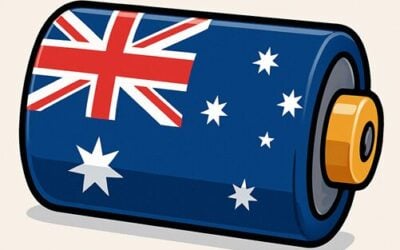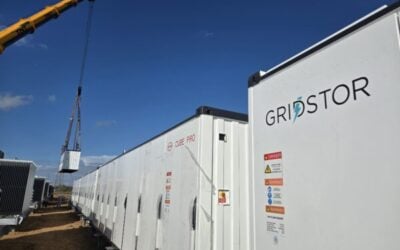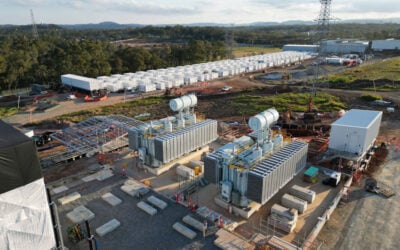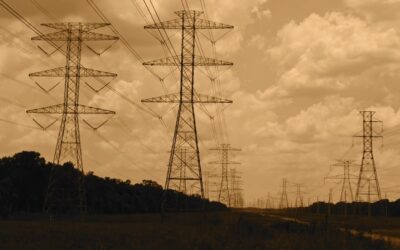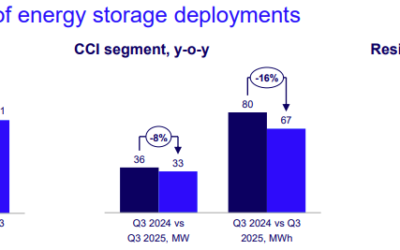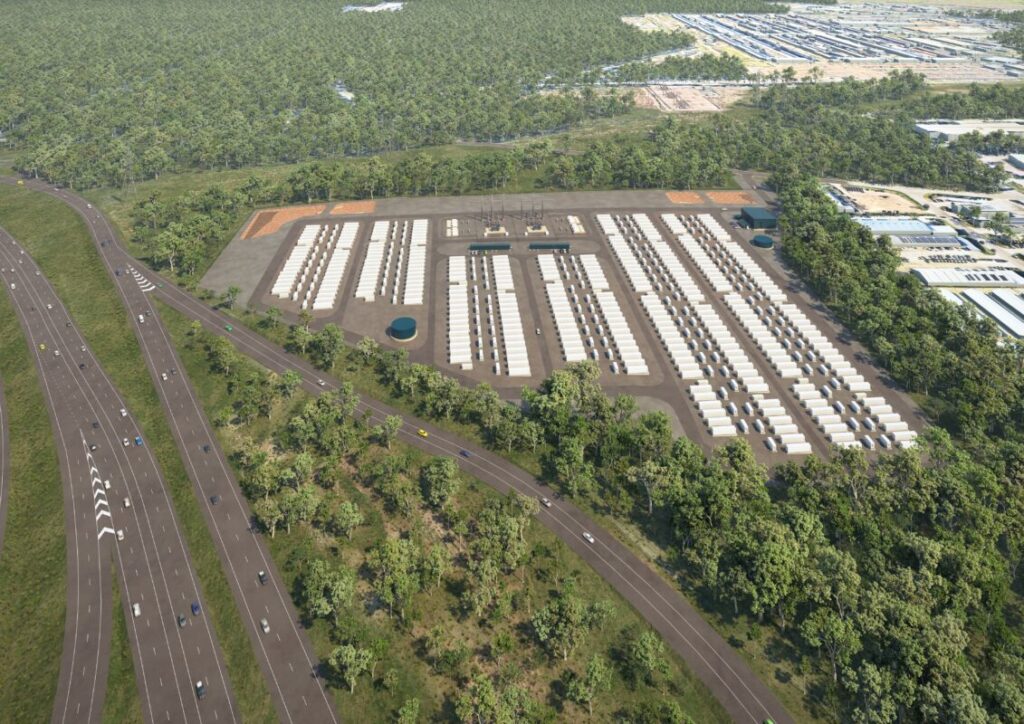
AGL Energy has disclosed that it deployed approximately AU$900 million (US$584 million) toward battery energy storage systems (BESS) and renewable energy in Australia during the fiscal year ending June 2025.
Nearly AU$500 million was allocated to growth capital expenditure, with a substantial portion directed toward the 500MW/1,000MWh Liddell Battery construction, which recently saw the first two transformers arrive at the site in New South Wales.
With FY2025 having seen AGL progress numerous utility-scale battery storage projects, the organisation confirmed that it now has a clear pathway to final investment decision (FID) for 900MW of grid-scale BESS projects.
AGL’s flexible fleet continues to increase since it released its cornerstone Climate Transition Action Plan in 2022. The document outlined a pathway for the Australian energy major to reach net zero emissions by 2050, including the need for 12GW of renewables and firming capacity by 2035.
Try Premium for just $1
- Full premium access for the first month at only $1
- Converts to an annual rate after 30 days unless cancelled
- Cancel anytime during the trial period
Premium Benefits
- Expert industry analysis and interviews
- Digital access to PV Tech Power journal
- Exclusive event discounts
Or get the full Premium subscription right away
Or continue reading this article for free
The organisation remains on target to reach this goal. The group has expanded its clean energy development pipeline to 9.6GW, which represents a tripling in size since the release of the Climate Transition Action Plan.
According to the results, AGL has grown its flexible fleet capacity to 8.3GW, incorporating a mix of battery storage, pumped hydro and gas peaking plants designed to provide dispatchable power when renewable energy generation is insufficient to meet demand.
On the topic of pumped hydro, AGL delved deeper into the long-duration energy storage (LDES) market in FY2025 by acquiring two early-stage pumped hydro energy storage (PHES) projects in the Upper Hunter region.
AGL acquired the two pumped hydro sites in May 2025, totalling 13,930MWh of LDES capacity. The two early-stage PHES sites, which are both 10-hour durations, were fully acquired from renewable energy developer Upper Hunter Hydro Top Trust. The two projects are the 770MW/7,700MWh Glenbawn and 623MW/6,230MWh Glennies Creek sites.
This complements AGL’s existing 3.2GWh Muswellbrook pumped hydro project, which is also located in the Upper Hunter region of New South Wales and currently in development.
These pumped hydro developments will enable AGL to provide multi-hour to multi-day storage capabilities, creating a diversified storage portfolio that addresses various grid needs.
Underlying net profit after tax drops 21% year-on-year
In terms of financial performance, AGL has posted an underlying net profit after tax of AU$640 million, representing a 21% decrease from the previous fiscal year.
The company recorded a statutory loss of AU$98 million, which included AU$596 million (post-tax) and a negative movement in the fair value of financial instruments of AU$142 million. These significant items encompassed an increase in onerous contracts of AU$398 million and Retail Transformation costs of AU$87 million.
The company’s underlying EBITDA reached AU$2 billion, which aligned with previous guidance but marked a 9% decrease from FY24 performance. AGL delivered underlying cash from operating activities (before significant items, interest, and tax) of AU$1.4 billion, which was AU$980 million lower than FY24.
This reduction was primarily due to a AU$381 million prepayment of bill relief received prior to the start of the financial year, of which AU$329 million has been credited to customer accounts over FY25.
Excluding this early prepayment from FY24 and the amount paid out from FY25, AGL’s operating cash flow was AU$1.8 billion, a decrease of AU$270 million, driven by outflows related to purchasing green certificates and coal.
The rate of conversion of EBITDA to operating cash flow, excluding the bill relief paid out, rehabilitation and margin calls, was 97%, consistent with the prior year.
AGL declared a final fully franked dividend for FY25 of 25 cents per share, bringing the total FY25 dividend to 48 cents per share.
The company maintained a 50% payout ratio for the full year, recognising ongoing funding and liquidity requirements, particularly for the construction of the Liddell and Tomago batteries and implementation of the Retail Transformation Program.
Improved enegry storage availability to enhance AGL’s capture value
Casting its eyes to the future, AGL expects to see an improvement in plant availability and fleet flexibility, including the commencement of operations of the Liddell Battery, which is on track to begin operations in early 2026.
Looking beyond FY26, AGL aims to offset any earnings impact from coal and gas re-contracting with earnings from its investment in flexible assets and broader strategy delivery.
This will be aided by the 500MW/2,000MWh grid-forming Tomago BESS in New South Wales, which is expected to be delivered and operational in late 2027. Fluence, a battery storage system integrator, clean energy software, and services company, will supply its Gridstack Pro for the utility-scale energy storage project.
AGL said that its long-term view acknowledges the challenges of transitioning from fossil fuels but demonstrates confidence that investments in renewable energy and storage will ultimately deliver sustainable returns.
Origin Energy committed to 6GWh energy storage portfolio
Another Australian energy major, Origin Energy, has positioned energy storage as a central pillar of its business strategy.
According to its FY2025 results, the company has now committed to approximately 1.7GW of battery projects with 6GWh of capacity. Construction is underway on multiple fronts, such as the 2.8GWh Eraring BESS in New South Wales.
The Eraring BESS development will deliver 2,800MWh of storage capacity across three stages. Construction commenced on Stages 2 and 3 during the fiscal year.
Stage 1 of the Eraring battery storage project is expected to become operational in the second half of FY2026. The Eraring BESS project is part of Origin’s plans to withdraw Australia’s largest coal-fired power station from service and instead contribute to the uptake of variable renewable energy generation technologies, such as wind and solar. It is located in the Eraring suburb of the City of Lake Macquarie, approximately 130km north of the state capital, Sydney.
Alongside the Eraring BESS, construction also started on the 300MW/650MWh Mortlake BESS in August 2024.
Situated at the Mortlake Power Station, Victoria’s largest gas-fired generator with a generating capacity of 566MW, the BESS is located adjacent to the Moorabool to Heywood 500kV transmission line, enabling it to connect to the National Electricity Market (NEM). The Mortlake BESS is expected to be commissioned late in 2026.
Discussing its energy storage portfolio, Origin states that, according to its guidance, it expects a “meaningful contribution” from its battery storage investments in the second half of FY2026.
Origin Energy’s statutory profit rises 6% year-on-year
Origin Energy has reported a statutory profit of AU$1.5 billion for FY2025, representing a 6% increase from the previous year’s AU$1.4 billion. The company’s underlying profit showed even stronger growth, rising 26% to AU$1.5 billion compared to AU$1.2 billion in FY2024.
However, underlying EBITDA decreased to AU$3.4 billion from AU$3.5 billion in the prior year, reflecting mixed performance across business segments.
The Energy Markets division experienced a 15% decline in underlying EBITDA to AU$1.4 billion, despite revenue increasing to AU$16.7 billion from AU$15.6 billion in FY2024.
This reduction was primarily attributed to lower electricity and natural gas gross profit margins in an increasingly competitive market environment.
Total revenue for FY2025 reached AU$17.2 billion, increasing 6.7% from AU$16.1 billion in the previous year. Electricity sales contributed AU$9.3 billion, while gas sales generated AU$4.5 billion, slightly down from AU$4.6 billion in FY2024. Pool revenue showed remarkable growth of 43% to AU$3.1 billion.
Origin said its capital allocation strategy has pivoted decisively toward battery storage and renewable energy projects. The company now has 1.7GW of battery projects committed and under development, forming a significant portion of its target to develop 4-5GW of renewables and storage by 2030.
For FY2026, Origin forecasts capital expenditure of AU$800 million to AU$1.1 billion, with AU$550-750 million allocated to growth initiatives primarily focused on battery storage and wind development projects.
Our publisher, Solar Media, will host the Battery Asset Management Summit Australia 2025 on 26-27 August in Sydney. You can get 20% off your ticket using the code ESN20 at checkout.

